
~~~~~~~~~~~~~~~~~~~~~~~~~~~~~~~~~~~~~~~~~~~
Live Earth Farm (Com)Post
3rd Harvest Week, Season 12
April 16th - 22nd, 2007
~~~~~~~~~~~~~~~~~~~~~~~~~~~~~~~~~~~~~~~~~~~
(click here for a pdf of the paper
version of this newsletter)
In this issue
--Greetings from Farmer Tom
--New Teen Adventure Camp!
--A story to make you smile
--Fava Beans
--Goat Milk Shares
--Four Fridays Mataganza Garden Internship
--More pictures!
--What's in the box this week
--Notes from Debbie's Kitchen
--Calendar
" We began as a mineral. We emerged into plant life
and into animal state, and then into being human, and always we have
forgotten our former states, except in early spring, when we slightly
recall being green again. "
~
Jelaluddin Rumi, Persian mystic poet, thirteenth century
Greetings from Farmer Tom
~~~~~~~~~~~~~~~~~~~~~~~~~~~~~~~~~~~~~~~~~~~~~~~~
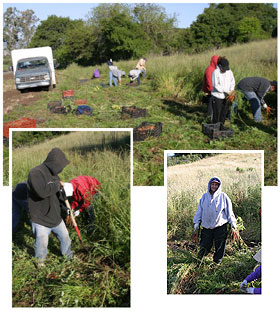
When growing food, whether by gardening or farming, one always ends
up developing a unique bond with the living earth. It's inevitable.
After more than a decade of working, walking, tasting, and breathing
the land, one gradually accumulates a "knowledge of place," an
understanding of how to read the weather, how to time plantings, what
to expect from soils, insects, diseases, animals, and most importantly
from each other. We who care for and help grow the crops you receive
every week work as a community of individuals who weave their expertise
into the larger and interconnected fabric of the farm. I like to compare
the farm to a dynamic living organism where each one plays a part,
like cells in a body. The food we eat is really an extension of this
living organism; by the time we bite into the carrots or strawberries
harvested just this morning (pictured here), a community of millions
of organisms have helped to get them onto our plates and into our mouths.
Imagine that the act of growing and eating food connects us to all
living creatures. Suddenly, Community Supported Agriculture takes on
a whole new meaning!
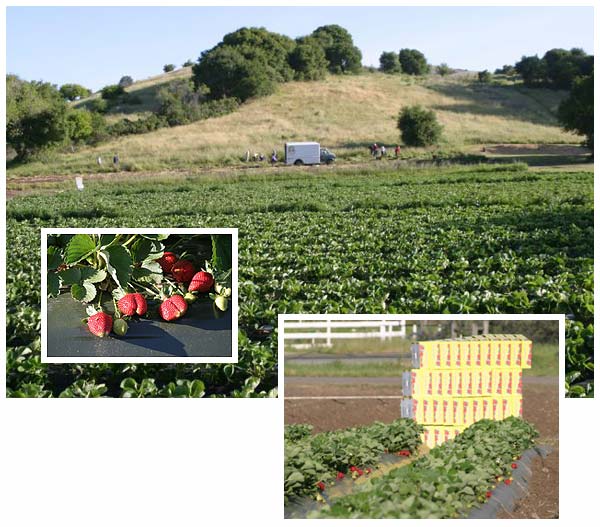
New Teen Adventure Camp!
~~~~~~~~~~~~~~~~~~~~~~~~~~~~~~~~~~~~~~~~~~~~~~~~
My interest has always been in opening the farm to the community – especially
to the younger generation – to allow for opportunities where barriers to
reconnecting with the natural environment can be dismantled. This year, we are
excited to add a Teen Adventure Camp to our regular seasonal events. It will
be a 5-day Camp here on the farm for teens/young adults (between 12 to 17 years
of age; kids only, no parents!), from Tuesday July 10th, to Saturday July 14th.
The Camp is limited to CSA members, and to no more than 10 children. It will
be a working exploration, experiencing life on the farm and surrounding environments.
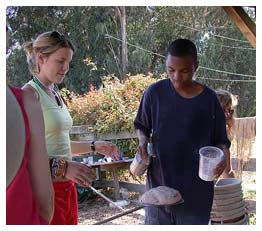 There will be harvesting, planting, milking, baking, weeding, watering, driving
or riding a tractor, washing, packing and selling vegetables, and discovering
the magic of growing nourishing and delicious fruits and vegetables. Although
this can be a strenuous experience, there will be plenty of free time to relax,
play, and socialize. The camp will end with a dinner celebration prepared by
the campers (parents welcome to join!) on Saturday afternoon. The cost is $350
per teen, all included. Discounts are available. Please contact Tom directly
at (831) 760-0436 if you are interested and would like more information.
There will be harvesting, planting, milking, baking, weeding, watering, driving
or riding a tractor, washing, packing and selling vegetables, and discovering
the magic of growing nourishing and delicious fruits and vegetables. Although
this can be a strenuous experience, there will be plenty of free time to relax,
play, and socialize. The camp will end with a dinner celebration prepared by
the campers (parents welcome to join!) on Saturday afternoon. The cost is $350
per teen, all included. Discounts are available. Please contact Tom directly
at (831) 760-0436 if you are interested and would like more information.
<back to top>
A story to make you smile
~~~~~~~~~~~~~~~~~~~~~~~~~~~~~~~~~~~~~~~~~~~~~~~~
A week or so ago I got an email from a brand new member; she said she didn’t get any garlic or chard in her share. Many of you asked 'the garlic question' (as I've come to call it), and have since learned that if you got something that looks like leeks, those’re green garlic. I described the chard to her too, and asked whether she got any green leafy veggies with colored stems (which range from white and yellow to orange, pink and red). Her reply just had me smiling the rest of the day:
And even more bizarre and hilarious, the chard turned into some wonderful "rhubarb" tarts. Delicious with lots of brown sugar and a sprinkling of flour!
Well, we're new at this. Adventures in vegetables! I'm having lots of fun discovering creative ways to use them (even more creative than I suspected!) :-).
Let me know if you’d like the “rhubarb” tart recipe! ;-)
<back to top>
Fava Beans
~~~~~~~~~~~~~~~~~~~~~~~~~~~~~~~~~~~~~~~~~~~~~~~~
The fava or bell beans we grow as a cover crop are not the edible kind, but their
close cousins, the commonly known “broad beans” are. They are much
larger, fat and oval. The favas we eat are highly regarded among people living
in countries once part of the Egyptian, Greek, and Roman world. Fava beans, a
kind of shell bean, are not as well known in America. When they come into season
in Italy, Romans go on countryside picnics where they feast on raw fava beans
with cold white wine. The beans are spread out on newspaper, shelled, and sprinkled
with Romano cheese. One of the more tedious aspects of preparing fava beans has
always been shelling and peeling them. The naked little beans are worth the trouble,
but you still wind up throwing out about two thirds of what you started out with.
This year, like last, we are fortunate to again have a large enough 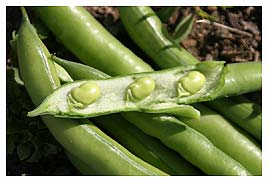 acreage of
favas planted that we can start harvesting them young and immature (see photo),
which means you can cook them whole (see Debbie’s recipes below). In the
next few weeks they will size up to where you no longer want to eat the pods
anymore, but for now, just eat them whole and avoid the hassle of shelling.
acreage of
favas planted that we can start harvesting them young and immature (see photo),
which means you can cook them whole (see Debbie’s recipes below). In the
next few weeks they will size up to where you no longer want to eat the pods
anymore, but for now, just eat them whole and avoid the hassle of shelling.
<back to top>
Goat Milk Shares
~~~~~~~~~~~~~~~~~~~~~~~~~~~~~~~~~~~~~~~~~~~~~~~~
by Lynn Selness of Summer Meadows Farm
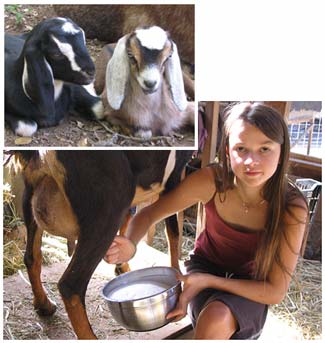
My daughter Meadow and I (that's her pictured at left) are basking in the warm
spring sun, watching with delight as our goat herd ravenously grazes our high
mountain pasture. This
is my favorite place, looking across the orchard’s delicate bloom to
the distant bay. We share such affection for each goat and their behaviors;
Fauna’s
new kid is blissfully asleep in the tall grass when Fauna suddenly misses her,
darts through the herd calling and frantically sniffing the other kids. So
Meadow finds little Asha and carries her to Fauna and all is well again. Meadow
and I are sketching the goats, trying to capture our glamorous does’ delicate
curves and shapeliness!
So we’ve begun another season with Live Earth Farm and are already delivering
milk to all the families signed up with us. Ten does have kidded so far, with
15 more still to birth, so we will add more families on as the milk comes. How
it works is you buy a share in one of our does; we milk her for you for the season
and offer you her milk: 1 gallon per week per share, or its equivalent in yogurt,
kefir, or cheese (ricotta or chevre). It is raw goat milk, and the cheeses are
all made by hand (mine!). You can create your combination. You can buy
half shares, or more than one also. Each share is $20 per week. You order directly
from us and pay us at Summer Meadows Farm, 405 Webb Road, Watsonville, CA 95076.
Our phone is (831) 786-8966. We send the milk to you via Live Earth’s amazing
delivery. You’ll pick up your milk in a cooler at your drop-site.
Here’s our story if you haven’t met us yet: I’ve milked goats
for over 30 years to raise my 7 children. These last few years, we’ve shared
our bounty with others. We’re so glad to hear some of our families’ stories
of overcoming health problems with our milk, dairy sensitive babies get happy
tummies and those with lactose intolerances are enjoying goat milk. Our Nubian
goats have high butterfat content for making rich cheese, but the molecules in
the milk are so easily digested and nourishing. My youngest children (Forest
and Meadow) and I run the farm, milking the goats by hand and making our yogurt,
kefir and artisan cheeses at home. The attentive care we give the goats and our
desire to see them live as naturally as possible in a herd keep them so content
and spoiled, we think they give the sweetest milk we’ve ever tasted! We
leave the newborn kids with their mothers for over a month and then only separate
them at night, the kids sleep together, so we can milk the does in the morning,
then they’re all together again all day. You should see the joyful
reunion every morning! Part of each day they graze the pastures; we feed hay
and grain needed for protein for the milking does, and they also get lovely organic
vegetable scraps from Live Earth Farm. We’re fencing new pastures right
now so we can rotate pastures and hope and pray we will get a watering system
in to prolong the growing season. All volunteer help is appreciated! We welcome
visitors to the farm; we love to meet our families and share our goats with
you. The new kids are so adorable right now! So thanks to those of you who
support us and make this all possible!
Love, Lynn, Forest and Meadow
Summer Meadows Farm
<back to top>
Four Fridays Mataganza Garden Internship
~~~~~~~~~~~~~~~~~~~~~~~~~~~~~~~~~~~~~~~~~~~~~~~~
Greetings CSA members and friends of the Live Earth Farm. My name is Brian Barth,
and as many of you know, I have been developing the Mataganza Garden Sanctuary
here on the farm, as well as related educational programs over the last few years.
This garden project transcends the production and market aspects of the farm
to focus on the educational, cultural, spiritual, and community aspects of the
vision we hold here. We've hosted dozens of interns and volunteers over the last
couple of years and recently completed a year-long Permaculture Design Course
here.
The garden project is still in a 'developing' stage and needs lots of people,
hands, and energy to continue to move it forward. Starting in mid-May I'll be
hosting a shorter (month-long) program for people wanting to get hands-on experience
in ecological gardening techniques, appropriate horticulture, natural building,
Permaculture Design, and other topics. It will happen on four consecutive Fridays,
from 10-6 each day: May 18th, May 25th, June 1st and June 8th. There will be
a $100 fee as a contribution towards the materials needed for our work in the
garden. Each day will include hands-on instruction relevant to the projects at
hand (to be determined by the needs of the garden) and will serve to tie theory
and practice together. Please call or email me at (831) 566-3336 or edenfruits2002@yahoo.comfor more info or to sign up. Happy Spring! – Brian
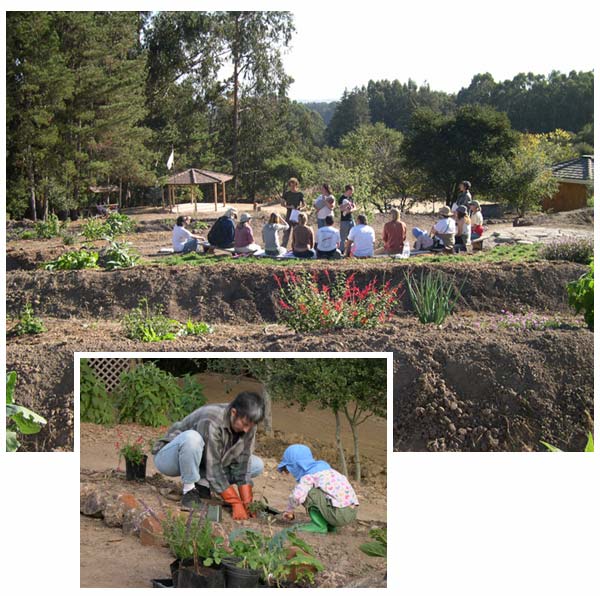
<back to top>
More pictures!
~~~~~~~~~~~~~~~~~~~~~~~~~~~~~~~~~~~~~~~~~~~~~~~~
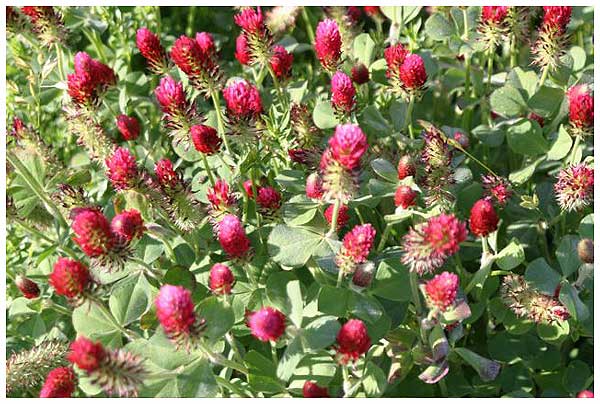
Beautiful red blossoms on cover crop clover!
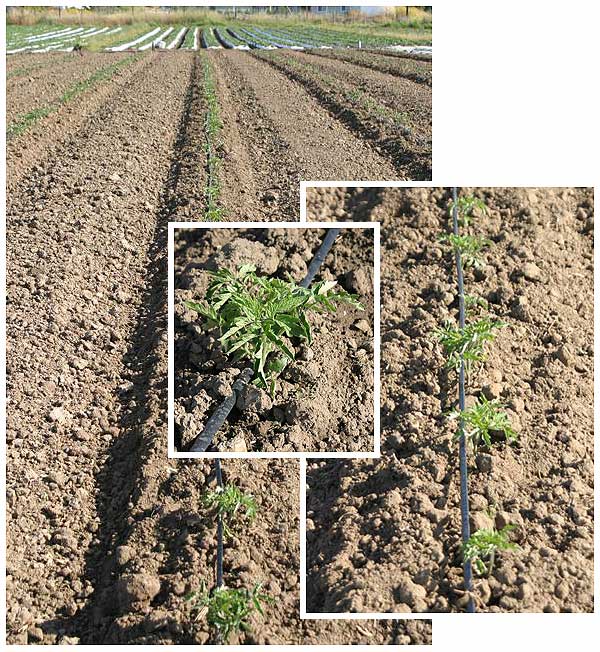
Newly planted tomato seedlings... summer, here we come!!
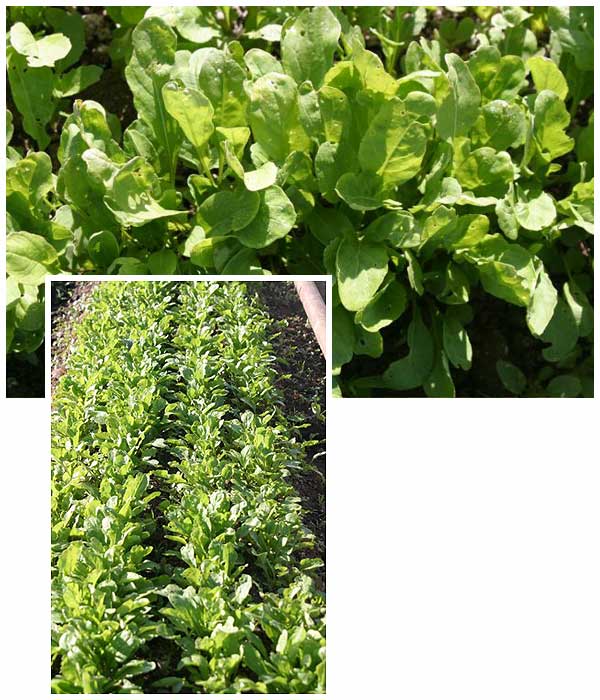
This is the arugula that will be cut and bagged in your shares.
What's in the box this week
~~~~~~~~~~~~~~~~~~~~~~~~~~~~~~~~~~~~~~~~~~~~~~~~
(Content differences between Family and Small
Shares are underlined and italicized; items with a “+” in
Family Shares are more in quantity than in Small; anticipated quantities
are in parentheses. Sometimes the content of your share will differ from what's
on this list, but we do our best to give you an accurate projection. It's Mother
Nature that throws us the occasional curve ball!)
Family Share:
Arugula
Beets
Broccoli (Lakeside)
Red or green cabbage
Carrots
Fava beans +
Green garlic
Kale or Chard
Lettuce (2) (LEF/Lakeside)
Onions
Strawberries (2-3 bskts.)
Small Share:
Arugula
Broccoli (Lakeside)
Red or green cabbage
Carrots
Fava beans
Green garlic
Lettuce (1) (LEF/Lakeside)
Onions
Strawberries (1-2 bskts.)
Extra Fruit Option:
(doesn’t start ‘til May)
Notes from Debbie's Kitchen
~~~~~~~~~~~~~~~~~~~~~~~~~~~~~~~~~~~~~~~~~~~~~~~~
Below is Beth's "Rhubarb" Tart recipe, plus
a few veggie tips on new things in the box this week. And
hey, I have a request! Now that I prepare this newsletter electronically
and can include pictures, this gave me an idea: if any of you ever
create a recipe that you're proud of, please take pictures and send them
to me! I'll share them with everyone else here in the newsletter. If
you're feeling adventurous, take pics of the steps or the process! Send
me the jpegs and I'll format them to fit the newsletter. I think it'll
be fun! – Debbie
Alt use for green garlic puree
Member Stacy McCann says, “I tried [last week’s] baked salmon in
green garlic puree, but used chicken instead and it was absolutely wonderful.
I pour all the sauce out over green beans and mashed potatoes on the plate and
the garlic and lemon made everything extra special.”
Arugula
The bag of smallish green leaves would be the arugula (see picture of it in the
field, above). It is a delicious, peppery green, which some people like to cook
with, but I prefer it raw as a salad green or as ‘bedding’ for cooked
meats or fish. Prep and storage: wash in a basin of water, pick out and discard
any yellow leaves or the occasional weed. Spin-dry, then air dry on a cotton
towel. Place in a plastic bag, squeeze out excess air, seal and refrigerate.
Here’s
how I recommend eating it (part of my ‘fruit-cheese-greens’ philosophy):
make a dressing with some fruity vinegar, a dab of Dijon mustard, pinch of salt,
and either olive oil or a nice nut oil. Throw a bunch of arugula in a bowl, slice
in fresh strawberries, crumble in some chevre or feta, maybe some toasted nuts,
toss with dressing and serve!
Young Fava Beans
The bag with what looks like giant green beans would be the young favas (you’ll
see in the coming weeks that they get MUCH bigger!). Prep and storage: These
you can just stick in the fridge in the bag they came in. To eat: top and tail
the pods, washing as needed, and cut into bite-size segments. Steam about 5 minutes,
then eat any number of ways: simply tossed with a little butter, salt and tarragon
(or other herb), or sauté up in olive oil with some chopped green garlic
and a little herbs de Provence. Or lightly oil, sprinkle with salt and grill
pods whole. In the next week or two I’ll talk about how to use the favas
when they get bigger.
Beth's Chard Stem "Rhubarb" Tarts
(see ‘story to make you smile’ above)
“Surprisingly, these really were good!” says Beth. “I used
just the stems of the chard, chopped up, and one pre-prepared pie crust which
I split into 6 and baked in a muffin pan. I made a latticed top for each tart,
and shortened the cooking time.”
4 C chopped rhubarb
1 1/3 C sugar
6 tbsp. flour
1 tbsp. butter
Pastry for a 9 inch double crust pie
Preheat oven to 450 degrees F (230 degrees C).
Combine sugar and flour. Sprinkle 1/4 of it over pastry in pie plate. Heap rhubarb
over this mixture. [I'd sprinkle on a little lemon juice – Debbie] Sprinkle with
remaining sugar and flour. Dot with small pieces of butter. Cover with top crust.
Place pie on lowest rack in oven. Bake for 15 minutes. Reduce oven temperature
to 350 degrees F (175 degrees C), and continue baking for 40 to 45 minutes. Serve
warm or cold.
Cilantro Pesto "Cesar" Salad
I finally made Randy Robinson's wonderful cilantro pesto (see last week's recipes)
as I had two bunches of cilantro I hadn't gotten around to using up yet (they'd
kept well; fresh as the day I got them!). I also had some dino kale (the really
dark green kind) – and followed his suggestion to use some of it instead of parsley
in the pesto. I was planning on having left-overs for dinner, but the pesto was
SO yummy I had to figure out how to incorporate some of it into the meal!
Necessity is the mother of invention, as they say ;-) So I took a spoonful of
it and made it into a salad dressing by thinning it with some more balsamic vinegar,
a little more lemon juice (I used lemon juice 'cause I have a lemon tree; that,
and I didn't have any limes. It tasted just fine!), a pinch more salt, and more
olive oil. Then I just washed, dried and chopped up a bunch of romaine lettuce
from last week's box and tossed it with the dressing. It was great!!
Alt use for green garlic purée
Member Stacy McCann says, “I tried [last week’s] baked salmon in
green garlic puree, but used chicken instead and it was absolutely wonderful.
I pour all the sauce out over green beans and mashed potatoes on the plate and
the garlic and lemon made everything extra special.”
Broccoli with Pine Nuts
from 'Recipes from a Kitchen Garden' by Renee Shepherd
and Fran Raboff
Serves 4
Renee says, "This recipe shows that less is more – its simplicity yields a delightful
dish best made with the freshest broccoli, just harvested from the garden." [Or
just taken out of your CSA share!]
2 lbs. very fresh broccoli
1 tbsp. olive oil
2 tbsp. unsalted butter
3 tbsp. freshly squeezed lemon juice
1/3 to 1/2 C pine nuts, lightly toasted
Divide broccoli into florets about 3 inches long (save stems for another dish).
[If we get lovely broccoli tops like we did last week, there will be no stems
to 'save' !] Drop broccoli florets into boiling salted water for a very brief
time, no more than 2 minutes, cooking them until just tender-crisp. Drain immediately
and put in ice water to stop cooking action. Drain and let dry on a clean kitchen
towel or paper towel.
Heat oil in a skillet, add butter and melt. Whisk in lemon juice. Add the broccoli
florets, stir to combine, and sauté for 3 to 5 minutes, turning the broccoli
and stirring constantly. Add toasted pine nuts in the last few minutes of cooking
and toss with broccoli, combining well to heat the nuts through. Serve immediately.
Jennifer Golden's Sesame Kale (or other greens)
Jennifer sent me the following in an email last week:
Since people are always interested in ideas for how to use up Kale, I wanted
to pass along this (rough)
recipe which is a delicious and simple way to enjoy
the vegetable, and other leafy greens. This is one of
those recipes I know well and just throw together,
rather than pay attention to amounts. The amounts
below are my best estimates:
Kale, and/or other greens
Toasted Sesame Oil (1/2 - 1 tsp. per bunch Kale)
Peanut Oil, or other (1-2 tbsp. per )
Tamari or Soy Sauce (2-4 tbsp. per )
Brown Sesame Seeds, toasted (1/4 C per )
Hot Chili Oil (optional) to taste (1/2 tsp.?)
Lemon Juice (optional) to taste
Boil a large pot of salted water. Clean Kale leaves, and dunk in boiling water for 5 minutes (less time if Kale is young, and for other greens). Greens should be cooked, but not mushy.
While greens are being prepped, lightly roast sesame seeds on stovetop.
When greens have cooked, rinse leaves thoroughly with cool water. Grab greens in fistfulls, and squeeze out as much water as possible.
Put greens in a small bowl, and break apart into individual leaves again as best as you can. Add other ingredients and combine well. Taste for balance of flavors, and adjust.
Yummy!
Beans 'n Greens, Italian Style
This was emailed to me last spring by member
Farrell Podgorsek. She modified it from a recipe by Sam Gugino [If any
of you remember, Sam was the food editor for the SJ Mercury News many
years ago! I always loved his stuff!]
Serves 2
1/2 lb Chicken Italian sausage
1 T olive oil
1 medium onion or some leeks, chopped
3 cloves garlic, chopped or some sliced green garlic
1 bunch broccoli raab, chopped, or the leaves of kale, chard, beet
greens or a combination, chopped
2/3 cup chicken or vegetable stock
1 can cannellini beans, drained and rinsed
Hot pepper flakes
Put sausage in a large, heavy skillet. Add ½ cup water, cover and put over medium high heat. Cook 5 minutes. Uncover and cook 5 to 6 minutes longer, until water evaporates and sausage is light browned and has no pink in the center. Lower heat when water evaporates completely and turn sausage once or twice to brown evenly. Set aside. When cooled slightly cut into I inch pieces.
While sausage cooks, put oil in a 12 inch sautepan or Dutch oven over medium heat. Saute onion and garlic until softened slightly. Add greens and stock. Increase heat to high. Add beans, salt & pepper to taste and hot pepper flakes, if desired. When mixture comes to a boil, stir well, cover and reduce heat to medium. Add sausage pieces. Cook about 4-5 minutes.
Farrell's Braised Red Cabbage
from
Farrell's same email as above recipe ;-)
red cabbage, thinly sliced - 1/2 large head or 1 small head
1/3 cup sugar
1/3 cup vinegar - cider, red wine or white wine
1/2 cup red wine jelly, currant jelly or fruit juice
enough water to keep bottom of pot moistened
salt to taste
Add all ingredients to a Dutch Oven. Bring to a boil and stir to dissolve sugar. Reduce to simmer, cover and cook about 30 minutes, or until it is as crunch or soft as you like. We like it somewhat crunchy. This is good served hot or cold and keeps quite a while in the refrigerator.
Calendar of Events
~~~~~~~~~~~~~~~~~~~~~~~~~~~~~~~~~~~~~~~~~~~~~~~~
(see calendar on website for more info)
<> Fri. May 18, Four Fridays Mataganza Garden Internship (5/18, 5/25,
6/1, 6/8)
<>
Sat. Jun 9 Outstanding in the Field Dinner
<> Sat. Jun 23 Summer Solstice
Celebration
<> July 10-14 Teen Adventure Camp
<> Aug 24-26 Childrens Mini-Camp
<>
Sat. Oct 20 Fall Harvest Celebration
<back to top>
Contact Information
~~~~~~~~~~~~~~~~~~~~~~~~~~~
email the farm: farmers@cruzio.com
email Debbie with newsletter input or recipes: deb@writerguy.com
phone: 831.763.2448
web: http://www.liveearthfarm.net
~~~~~~~~~~~~~~~~~~~~~~~~~~~